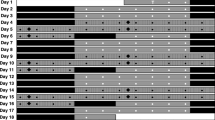Summary
The effects of single oral doses of 10 and 20 mg ebastine were compared with placebo and 2 mg clemastine in a double-blind cross-over study in 16 healthy male volunteers.
Clemastine produced the known pattern of changes, namely impairment of psychomotor performance, drowsiness, and a selective effect on cognitive processes. Earlier encoding in a perceptual stage was slowed whereas abstract classification processes were not affected. Electrophysiological measures of vigilance showed a general decrease in vigilance especially 2.5 and 4.5 h after dosing.
In contrast at no time was any effect of ebastine different from that of the placebo.
Ebastine 10 and 20 mg differed positively from clemastine in its effect on pursuit tracking, subjective rating of drowsiness and general discomfort. Ebastine 10 mg also differed positively from clemastine in the EEG features of vigilance.
It is concluded that 10 and 20 mg ebastine were free from sedative adverse effects.
Similar content being viewed by others
References
Beringer J (1988) Experimentelles Run Time System (ERTS), Vers 2 (Handbook), Technische Hochschule Darmstadt, Institut für Psychologie
Cheng HC, Woodward JK (1982) Antihistaminic effect of terfenadine: A new piperidine-type antihistamine. Drug Dev Res 2: 181
Clarke CH, Nicholson AN (1978) Performance studies with antihistamines. Br J Clin Pharmacol 6: 31–35
Douglas WW (1985) Histamine and 5-hydroxytryptamine (Serotonin) and their antagonists. In: Goodman J, Gilman A (Eds) The pharmacological basis of therapeutics. Macmillan, New York, pp 605–638
Frowein HW (1981) Selective effects of barbiturate and amphetamine on information processing and response execution. Acta Psychol 47: 105–115
Görtelmeyer R (1986) Schlaffragebogen A und B. In: Internationale Skalen für Psychiatrie CIPS (Ed). Beltz, Weinheim
Herrmann WM, Fichte K, Kubicki S (1980) Definition von EEG-Frequenzbändern aufgrund strukturanalytischer Betrachtungen. In: Kubicki S, Herrmann WM, Laudahn G (Eds), Faktorenanalyse und Variablenbildung aus dem Elektroencephalogramm. Fischer, Stuttgart, pp 61–74
Herrmann WM, Kern U, Röhmel J (1986) Contribution to the search for vigilance-indicative EEG variables. Results of a controlled, double-blind study with pyritinol in elderly patients with symptoms of mental dysfunction. Pharmacopsychiat 19: 75–83
Janke W, Debus G (1978) Die Eigenschaftswörterliste (EWL) — Ein Verfahren zur Erfassung der Befindlichkeit. Hogrefe, Göttingen
Lehmann E (1973) Experimentelle Untersuchungen zur Wirkung verschiedener Dosierungen eines Tranquilizers (Mepiprazol) unter variierten situativen Bedingungen. Dissertation der Mathematischen Fakultät, Universität Düsseldorf
Matejcek M (1982) Vigilance and the EEG: Psychological, physiological and pharmacological aspects. In: Herrmann WM (ed), Electroencephalography in drug research. Fischer, Stuttgart, pp 405–508
Peck AW, Fowle ASE, Bye C (1975) A comparison of triprolidine and clemastine on histamine antagonism and performance tests in man: implications for the mechanism of drug induced drowsiness. Eur J Clin Pharmacol 8: 455–463
Posner MI, Mitchell RF (1967) Chronometric analysis of classification. Psychol Rev 74: 392–409
Revidierte Deklaration von Helsinki (Anlage 1 der Bekanntmachungen von Beschlüssen des Weltärztebundes vom 16.Mai 1987). Bundesanzeiger Nr 108, vom 13. Juni 1987:7109
Seppälä T, Nuotto E, Korttila K (1981) Single and repeated dose comparison of three antihistamines and phenylpropanolamine: psychomotor performance and subjective appraisals of sleep. Br J Clin Pharmacol 12: 179–188
Schoppe KJ (1974) Das MLS-Gerät: Ein neuer Testapparat zur Messung feinmotorischer Leistungen. Diagnostika XX/1: 43–46
Van Wauwe J, Awouters F, Niemegeers CJE, Janssens F, van Nueten JM, Janssen PAJ (1981) In vitro pharmacology of astemizole, a new type of H1-antihistamine compound. Arch Int Pharmacodyn Ther 251: 39
Vincent J, Liminana R, Meredith PA, Reid JL (1988) The pharmacokinetics, antihistamine and concentration-effect relationship of ebastine in healthy subjects. Br J Clin Pharmacol 26: 497–502
Author information
Authors and Affiliations
Rights and permissions
About this article
Cite this article
Hopes, H., Meuret, GH., Ungethüm, W. et al. Placebo controlled comparison of acute effects of ebastine and clemastine on performance and EEG. Eur J Clin Pharmacol 42, 55–59 (1992). https://doi.org/10.1007/BF00314920
Received:
Accepted:
Issue Date:
DOI: https://doi.org/10.1007/BF00314920




